Tait TEL0051 Mobile Transceiver User Manual Operators Manual T2020
Tait Limited Mobile Transceiver Operators Manual T2020
Tait >
Contents
- 1. Manual and Installation Guide
- 2. Installation Guide T2000
- 3. Operators Manual T2020
- 4. Operators Manual T2040
Operators Manual T2020
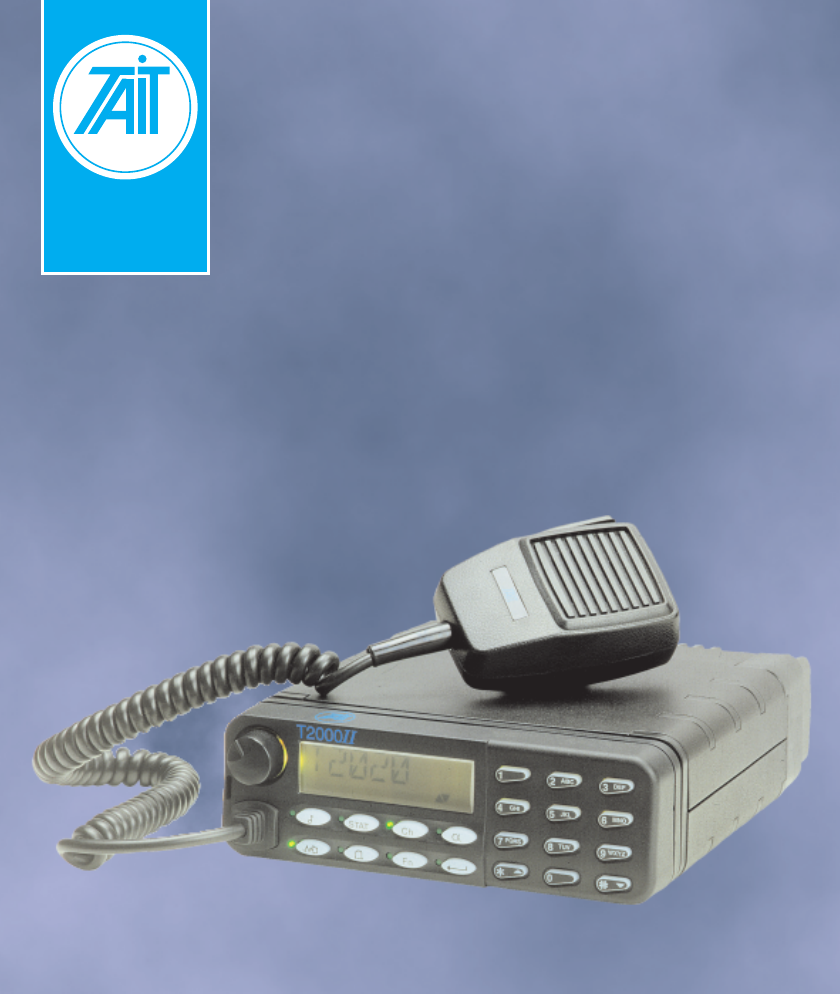
Operator’s Manual
T2020 Series II
T2020II

1
TAIT ELECTRONICS LIMITED
Software licence agreement
This legal document is an Agreement between you, (the “Licencee”) and Tait Electronics Limited (“Tait”). By opening this product package and/or using the product you
agree to be bound by the terms of this Agreement. If you do not agree to the terms of this Agreement, do not open the product package and immediately return the
unopened product package to Tait. If you open the product package that will be deemed to be acceptance of the terms of this licence agreement.
Licence
In consideration of the payment of the Licence Fee which forms part of the price you paid for products you acquired from Tait or its subsidiary or agent (the “products”)
and our willingness to be bound by the terms of this agreement, Tait grants to you as Licencee the non-exclusive right to use the copy of a Tait software program
included in the products, (the “Software”).
In particular the Licencee may use the program on a single machine and if the software is supplied on a diskette, the licensee may:
(a) Copy the program into any machine readable or printed form for backup purposes in support of your use of the program on the single machine
(Certain programs, however, may include mechanisms to limit or inhibit copying. They are marked “copy protected”), provided the copyright notice
must be reproduced and included on any such copy of the Software.
(b) Merge it into another program for your use on the single machine. (Any portion of this program merged into another program will continue to be
subject to the terms and conditions of this Agreement.);
The Licencee may not duplicate, modify, reverse compile or reverse assemble the Software in whole or part.
Title to software
This agreement does not constitute a contract of sale in relation to the Software supplied to the Licencee. Not withstanding the Licencee may own the magnetic or other
physical media on which the Software was originally supplied, or has subsequently been recorded or fixed, it is a fundamental term of this Agreement that at all times
title and ownership of the Software, whether on the original media or otherwise, shall remain vested in Tait or third parties who have granted licences to Tait.
Term and termination
This Licence shall be effective until terminated in accordance with the provisions of this Agreement. The Licencee may terminate this Licence at any time by destroying
all copies of the Software and associated written materials. This Licence will be terminated automatically and without notice from Tait in the event that the Licencee
fails to comply with any term or condition of this Agreement. The Licencee agrees to destroy all copies of the Software and associated written materials in the event of
such termination.
Limited warranty
The Software is supplied by Tait and accepted by the Licencee “as is” without warranty of any kind either expressed or implied, including but not being limited to any
implied warranties as to merchantability or fitness for any particular purpose. The entire risk as to the quality and performance of the Software vests in the Licencee.
Should the Software prove to be defective, the Licencee (and not Licensor or any subsidiary or agent of the Licensor) shall assume the entire cost of all necessary
servicing, repair or correction. Tait does not warrant that the functions contained in the Software will meet the Licencee’s requirements or that the operation of the
Software will be uninterrupted or error free. However Tait warrants that the diskettes if any on which the Software is supplied to the Licencee shall be free from defects
in material and workmanship under normal use and service for a period of ninety (90) days from the date of delivery to the Licencee.
Exclusion of liability
Tait’s entire liability and the Licencee’s exclusive remedy shall be:
1. The replacement of any diskette not meeting Tait “limited warranty” and which is returned to Tait or an authorised agent or subsidiary of Tait with a
copy of the Licencee’s purchase receipt; or
2. If a diskette is supplied and if Tait is unable to deliver a replacement diskette which is free from defects in material or workmanship, the Licencee may
terminate this Agreement by returning the Software to Tait.
3. In no circumstances shall Tait be under any liability to the Licencee, or any other person whatsoever, for any direct or consequential damage arising
out of or in connection with any use or inability of using the Software.
4. Tait warrants the operation of the Software only with the operating system for which it was designed. Use of the Software with an operating system
other than that for which it was designed may not be supported by Tait, unless otherwise expressly agreed by Tait.
General
The Licencee confirms that it shall comply with the provisions of law in relation to the Software.
Law and jurisdiction
This Agreement shall be subject to and construed in accordance with New Zealand law and disputes between the parties concerning the provisions hereof shall be
determined by the New Zealand Courts of Law. Provided however Tait may at its election bring proceedings for breach of the terms hereof or for the enforcement of any
judgement in relation to a breach of the terms hereof in any jurisdiction Tait considers fit for the purpose of ensuring compliance with the terms hereof or obtaining relief
for breach of the terms hereof.
No Dealings
The Licencee may not sublicense, assign or transfer the licence or the program except as expressly provided in this Agreement. Any attempt otherwise to sublicense,
assign or transfer any of the rights, duties or obligations hereunder is void.
No Other Terms
The Licencee acknowledges that it has read this agreement, understand it and agree to be bound by its terms and conditions. The Licencee further agrees that this
is the complete and exclusive statement of the agreement between it and Tait in relation to the Software which supersedes any proposal or prior agreement, oral or
written and any other communications between the Licencee and Tait relating to the Software. (LS-589)

2

3
Contents
Introduction ....................................................................................... 5
Safety Training Information ........................................................... 6
WARNING ............................................................................. 6
Basic Operations .............................................................................. 7
Key functions ................................................................................ 7
Indicators And Display Functions ................................................. 8
Display Window ..................................................................... 9
Display Window Indicators ........................................... 10
Standard Operations ...................................................................... 10
Switching the Radio On and Off ................................................. 10
Switching the Radio On....................................................... 10
Switching the Radio Off....................................................... 10
Selecting a Channel or a Group ................................................. 10
Selecting a Channel ............................................................ 10
Selecting a Group ............................................................... 11
Receiving a Call ......................................................................... 11
Monitor Key ................................................................................ 11
Making a Call ............................................................................. 12
Transmit Timer ..................................................................... 13
Economy Mode .......................................................................... 13
Scanning Channels .................................................................... 13
To Activate Scanning ........................................................... 13
To Stop Scanning ................................................................ 14
Making a Call ...................................................................... 14
Using Selcall (Selcall Option Fitted) .......................................... 14
Making a Selcall Call ........................................................... 14
Group Calls ......................................................................... 16
Receiving a Selcall Call ...................................................... 17
Advanced User Operations ............................................................ 19
Alphanumeric Entry Mode .......................................................... 19
Repeater Talkaround .................................................................. 20
Sending DTMF Tones (DTMF Option Fitted) ............................ 21
User Programmable Scan .......................................................... 22
Call Queuing (Selcall Option Fitted).......................................... 23
Call Queue Not Empty ........................................................ 23
Accessing the Call Queue ................................................... 23
Exiting the Call Queue ........................................................ 24
Queuing Calls ..................................................................... 24

4
Contents (continued)
Call Queue Full ................................................................... 24
Changing the Selcall Status Code (Selcall Option Fitted).......... 25
Diverting a Received Call (Selcall Option Fitted) ...................... 25
Activating Call Diversion Mode ........................................... 25
Exiting Call Diversion Mode ................................................ 26
Receiving a Call During Call Diversion ............................... 26
Making a Call to a Radio in Diversion Mode ....................... 27
Emergency Operation (Selcall Option Fitted) ........................... 27
Other Selcall Features ............................................................... 27
Altering User Options ................................................................. 28
Optional Accessories for the T2020
II
Radio ................................ 30
Appendix .......................................................................................... 31
Maintenance of your T2020
II ...............................................
31
Troubleshooting .......................................................................... 31
Despatcher Operation ................................................................ 31
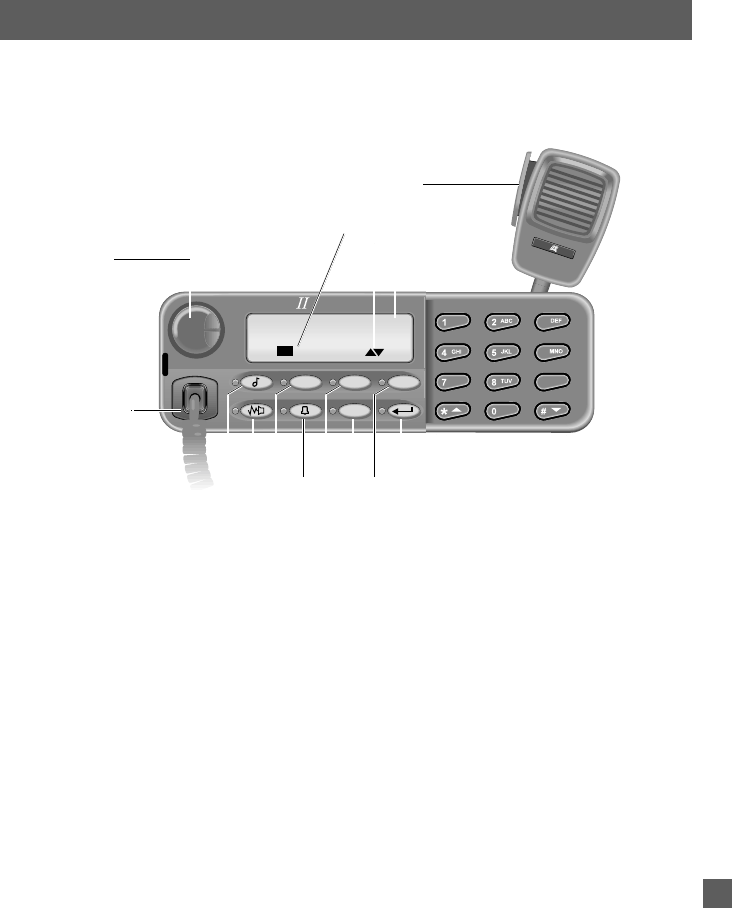
5
3
6
9
PQRS
WXYZ
STAT
Ch
Fn
α
T2000
TX SCANBUSY WAIT
Introduction
The Tait T2020
II
radio is a state-of-the-art mobile radio that provides outstanding communication flex-
ibility and a wide range of innovative features. The T2020
II
is microprocessor controlled so that it can
be configured to suit your personal needs and those of your fleet, for greater communication effective-
ness.
Call key
Status key
Microphone
socket
Auxiliary key
Monitor key
Channel key
Enter key
ON/OFF - Volume
knob
PTT key
Keypad
Display window
Scrolling available
indicator
Transmit indicator
Function key
Alphanumeric key
T2020
II
Control Head
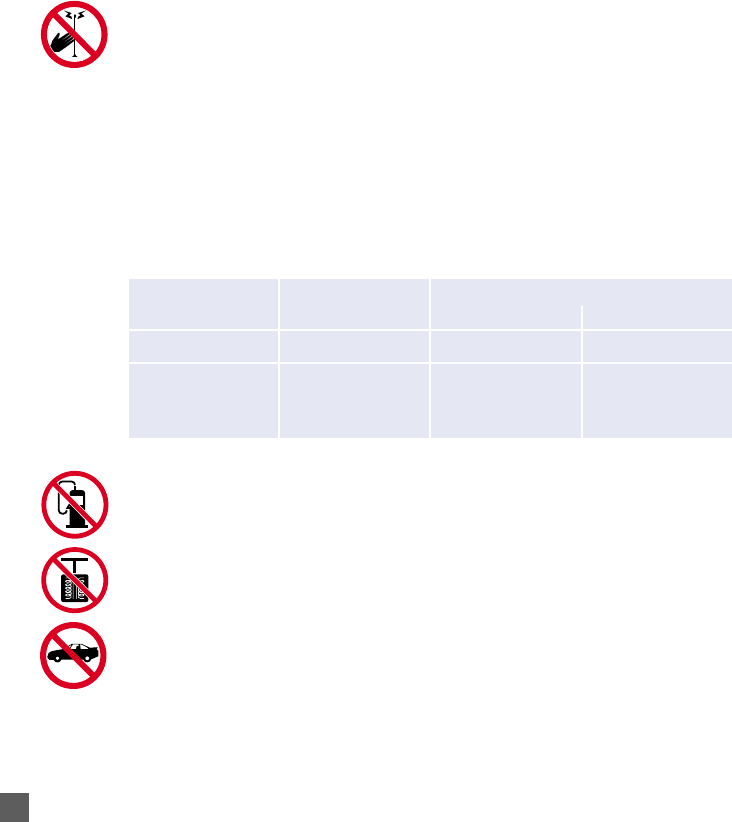
6
Safety Training Information
Warning:
This product generates Radio Frequency energy during transmissions. It is classi-
fied as suitable for ‘Occupational Use Only’. It is not intended for general use in
uncontrolled environments.
It must only be used with authorised accessories and antennas.
The operator must ensure that the minimum safe distance between persons and
the antenna is maintained during transmissions.
Do not exceed a duty cycle ratio of 50% transmit mode to standby or receive modes.
The radio is in transmit mode when the PTT button on the microphone is pressed
or the ‘TX’ indicator shows.
Safe distances from each antenna are as follows:
Switch the radio off at petrol filling stations.
T20X0-K27
T20X0-3XX
Product Minimum Safe DistanceAntenna Gain
(dBi) (metres) (inches)
4.5
2.15
5.15
0.82
0.63
0.88
32.4
24.6
34.8
Switch the radio off in the vicinity of explosive devices (such as in a quarry that
uses blasting techniques).
Use of a handheld microphone or a radio while in the act of driving could contra-
vene the legislation that applies in your country or state. Please check the vehicle
regulations in your own country.
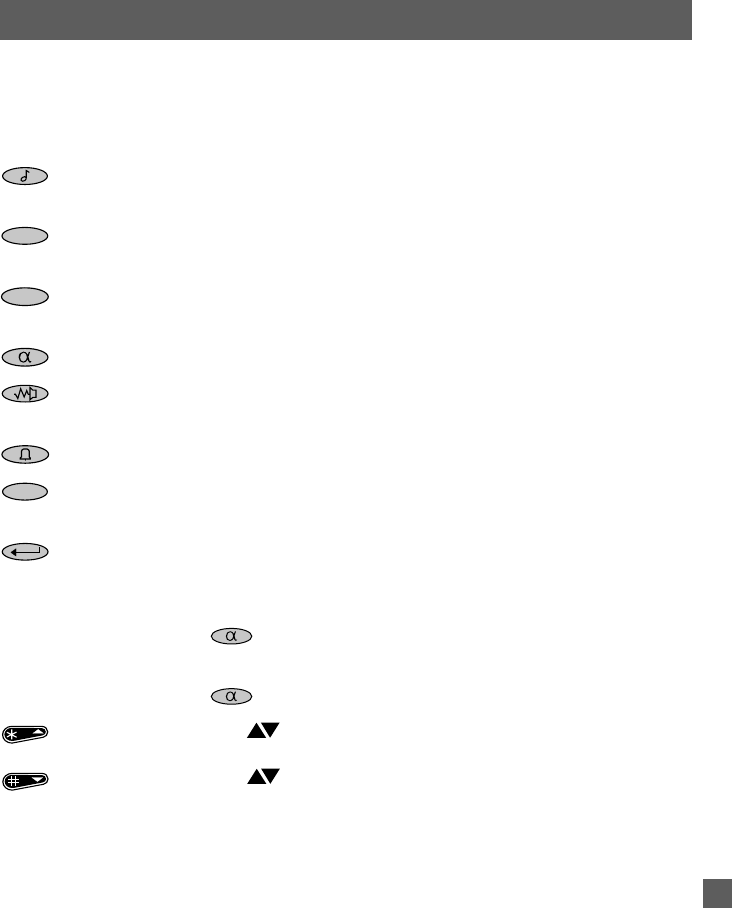
7
Basic Operations
The T2020
II
control head includes the following keys and indicators:
Key Functions
The keypad functions are as follows:
Call Used to activate the Selcall function, to enable you to make calls to other
users.
Status Used to select preprogrammed status messages to indicate your own
present status (such as ‘EN ROUTE’ or ‘AT LUNCH’).
Channel Used to select a channel, a scan group, a number or a label associated
with the channel name, and to access the Repeater Talkaround option.
Alphanumeric Used to turn on Alphanumeric mode.
Monitor Used to access to the signalling mute and RF squelch control of your
receiver.
Auxiliary Used to control an auxiliary hardware option.
Function Used to customise the operation of your radio to suit your own require-
ments.
Enter Used to complete dialling entries. (Used for channel entry, Selcall calls,
DTMF dialling, alphanumeric entry and option selections.)
0 to 9 Used for dialling numbers when the indicator beside the Alphanumeric
() key is
not
illuminated.
[ABC] to [WXYZ] Used for entering letters when the indicator beside the Alphanumeric
() key is illuminated.
Star/Up If the ‘’ indicator is displayed in the display window, these keys are
used to scroll up and down through a list of choices.
Hash/Down If the ‘’ indicator is not displayed in the display window, they act as
dialling keys for Selcall and DTMF dialling.
STAT
Ch
Fn
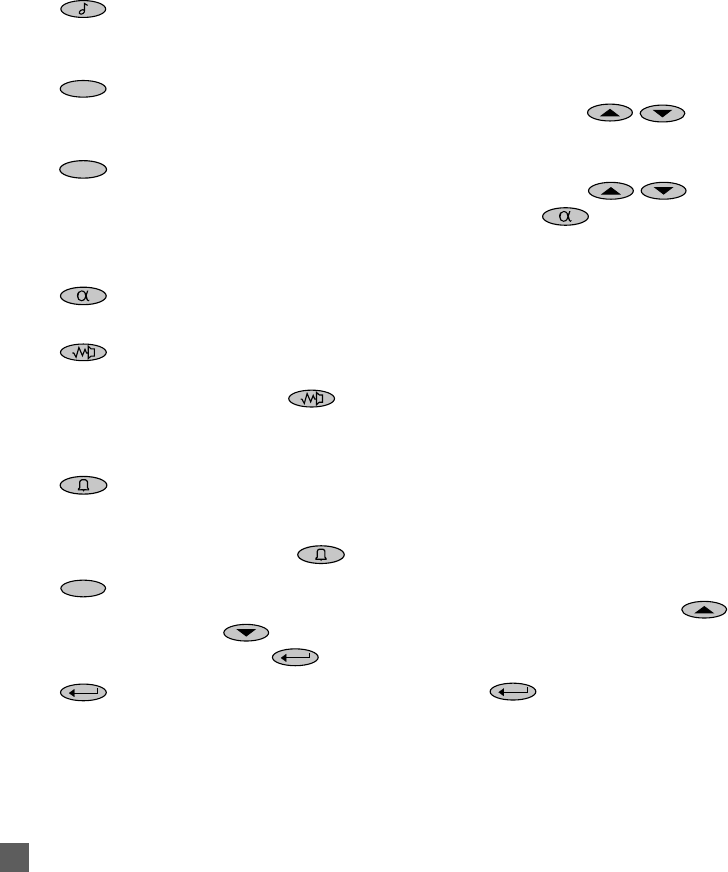
8
Indicators and Display Functions
●
Indicates that your radio has received a Selcall call. If the indicator is flash-
ing, your radio received a call which you were unable to answer. Your radio
may be programmed to display your caller's identity.
●
Indicates that your radio is ready for you to select a status code relating to
your current activity. You may use the Up and Down ( /) scroll
keys to choose a status code or description from a list.
●
Indicates that your radio is ready for you to enter information to enable it to
select a new channel. You may use the Up and Down ( /) scroll
keys to choose from a list, the Alphanumeric ( ) key to enter a label,
or the number keys. If the indicator is flashing, the current channel is in
Repeater Talkaround mode.
●
Indicates that you can enter information, such as a channel label, from the
keypad, using letters or numbers.
●
If this indicator is on continuously, the signalling mute (if active) is open. This
may be because either the microphone is off-hook, or you have pressed the
Monitor ( ) key. If the indicator is continually flashing, the Monitor key
has been pressed for long enough to open the RF squelch.
Note:
When the radio is operating normally, this indicator is off.
●
Indicates the state of the auxiliary options switch. Depending upon the pro-
grammed configuration of the auxiliary options switch, this indicator may be
either on continuously or off continuously, or may only come on while the
Auxiliary ( ) key is pressed down.
●
Indicates that you can change the user programmable options. The display
window shows the option last viewed. You may use the Up and Down (/
) scroll keys to move through the options, then select one with the
Enter ( ) key.
●
Indicates you have pressed the Enter ( ) key.
When these indicators are all off, the radio is in DTMF mode. It can now
transmit DTMF tones, entered via the keypad.
STAT
Ch
Fn
CALL, STATUS, CHAN-
NEL, ALPHANUMERIC &
FUNCTION indicators all
off
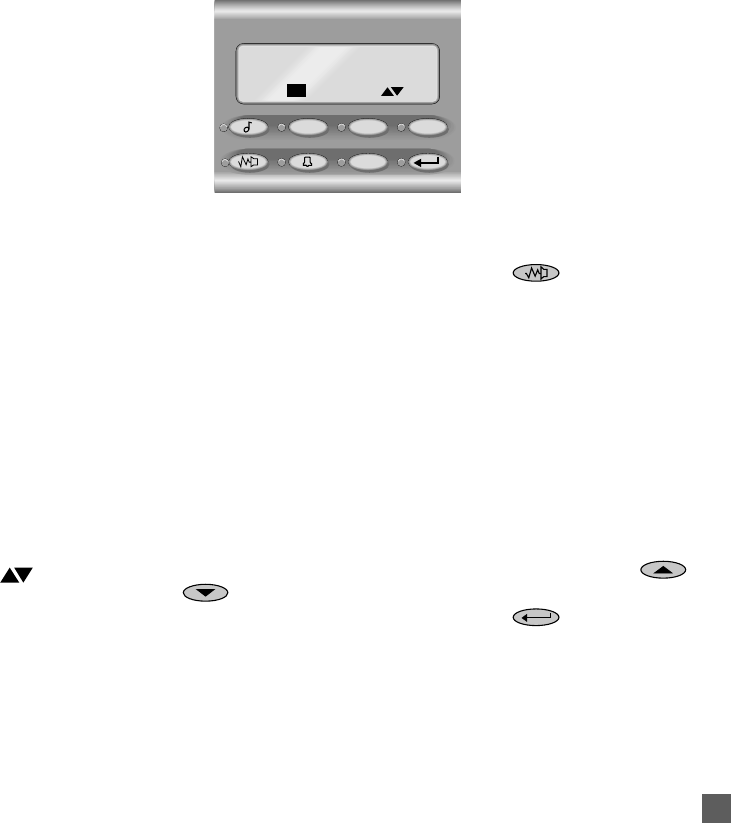
9
Display Window
The LCD display window provides you with direct visual access to information and messages about the
status of your calls and your radio.
Display Window Indicators
BUSY
Busy
- This appears whenever there is activity on you current channel. If the
signalling mute on your radio is closed (see the function), you may
not hear the traffic until you lift your microphone off-hook.
TX
Transmit
- Your radio is transmitting. This message is displayed when you
press the PTT key. It should also come on briefly when your radio makes a
Selcall or DTMF call.
SCAN
Scan
- Your radio is sampling each of a group of channels for any activity.
When it detects activity, it pauses on that channel for as long as the channel
carries traffic and then resume scanning.
WAIT
Wait
- The channel you are using is busy and your call has been deferred.
The radio gives you an alerting signal to indicate that the channel is now
free.
Scrolling available
- You are now able to use the Up and Down ( /
) scroll keys to move through a list of choices. Having found an ap-
propriate choice with the keys, push the Enter ( ) key to select.
STAT Ch
Fn
α
TX SCANBUSY
T2000
II
WAIT
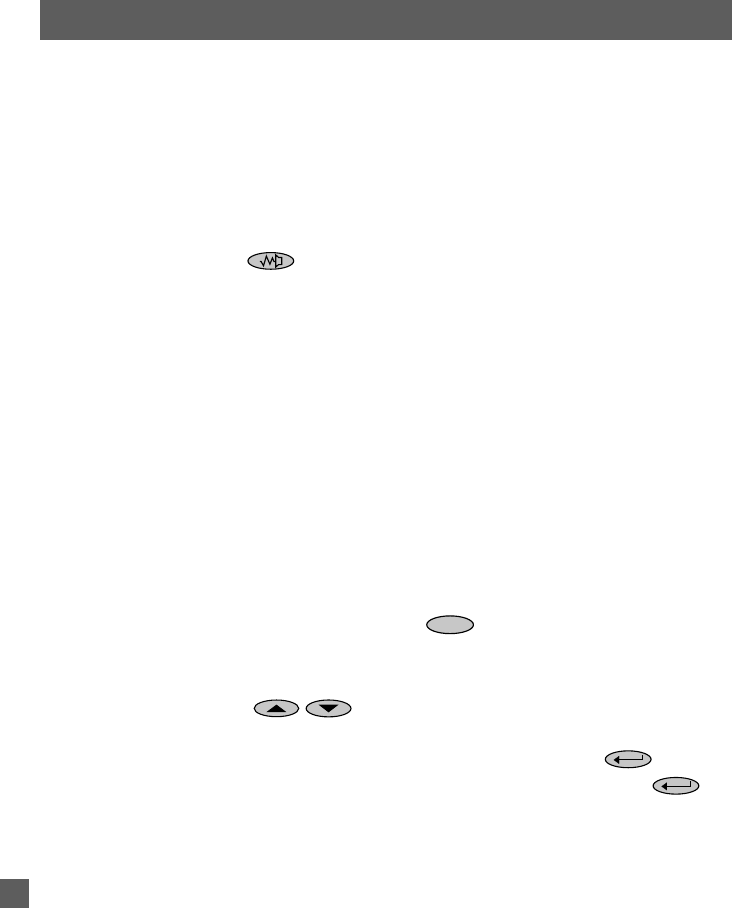
10
Standard Operations
Switching the Radio On and Off
Switching the Radio On
Switch the radio on by rotating the volume knob clockwise to about one third of its maximum setting.
The control head display then shows a power-up message.
When first switched on, the radio resumes operation on the same channel as when it was last switched
off.
Press and hold the Monitor ( ) key until the indicator flashes. The radio then emits two short
tones. Depress the key briefly to return the radio to the quiet state. The radio then emits a short tone.
You may need to finally set the volume level when you receive your first call.
Switching the Radio Off
Switch the radio off by rotating the volume knob anticlockwise, to its primary position.
The T2020
II
retains some settings that are used when it is switched on again.
Selecting a Channel or a Group
Selecting a Channel
When first switched on, the radio resumes operation on the same channel as when it was last switched
off.
To check the current channel:
●
Select Channel mode by pressing the Channel (
Ch
) key, and the current channel name
appears in the display window.
To select a new channel:
●
Press the Up and Down ( /) scroll keys on the keypad to move through the list of the
available channels, until the display shows the identity of the required channel, or
●
Use the numeric keypad to enter a new channel number, then press the Enter ( ) key, or
●
Use the alphanumeric keypad to enter an alphanumeric label, then press the Enter ( ) key
to initiate the call.
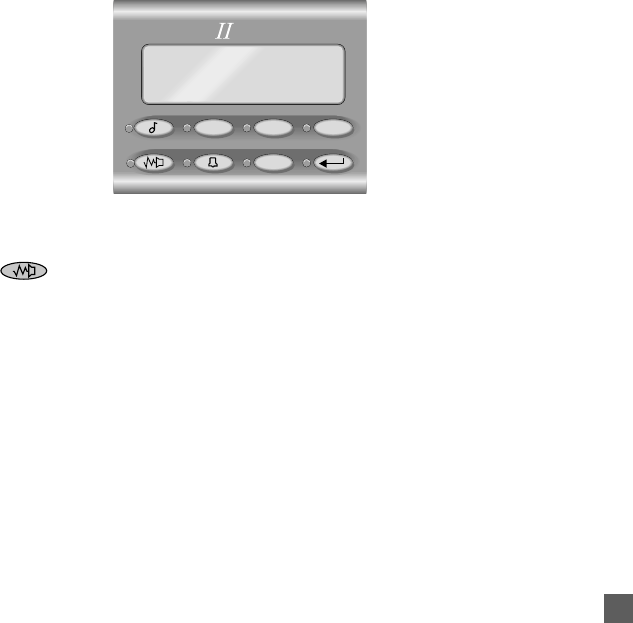
11
STAT
Ch
Fn
α
BUSY
T2000
Selecting a Group
A group is simply a collection of channels grouped together for scanning or voting. Select a group the
same way as a channel.
Receiving a Call
The T2020
II
remains muted until another user makes a call. Listen for your call-sign when you hear
activity, and reply promptly by identifying yourself (for example ‘Mobile-9 receiving’).
The BUSY indicator in the display appears whenever there is any activity on the channel. Your radio
may only unmute the speaker for some of this activity, depending on which signalling options are fitted
to your radio. Consult your Tait dealer about the signalling options available.
Using the Monitor Key
The Monitor ( ) key enables you to monitor a channel for other users, regardless of the muting
controls programmed into your radio. There are three types of muting control which may screen your
calls:
RF squelch
Permits reception only if the radio's signals exceed a preset threshold. This
ensures that only intelligible signals are audible.
CTCSS or DCS mute
Permits reception only if a signal carries an inaudible tone or code specific to
your fleet or group.
Selcall mute
Permits reception only if the signal carries a special audible tone sequence
at the beginning of the transmission.
Note:
The RF Squelch is always programmed to operate in your radio, but the CTCSS, DCS or
Selcall mutes are optional, depending on the way your radio is programmed.
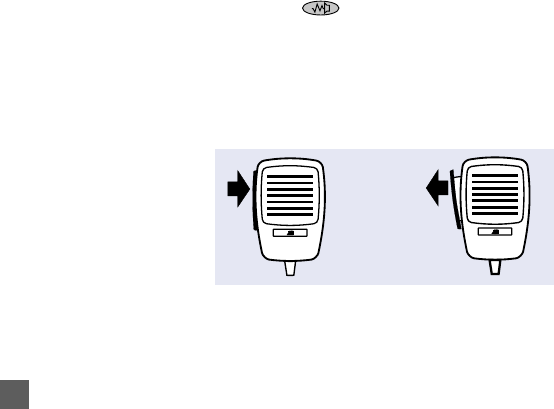
12
The Monitor key may be programmed to override one or more of the mutes. Occasionally, you may find
the message you are receiving is still intelligible, but is being cut off periodically by the RF squelch. In
this case, you can force the radio to leave the RF squelch open continuously.
The most common configuration is as follows:
●
Press the Monitor key briefly (less than one second) to override CTCSS/DCS or Selcall signal-
ling mute. (If hookswitch monitoring is programmed, lifting the microphone off-hook has the same
effect.)
●
To also override the RF squelch, hold the Monitor key for more than one second, until the radio
sounds two short tones,
beep beep,
and the MONITOR indicator flashes. Press again to restore.
Your T2020
II
may be fitted with the ability to hush (mute) another device, such as a car stereo, so that your
speech is clearly audible to other users when you transmit a call. Consult your Tait dealer to see if this
facility is active on your radio.
Making a Call
Select the desired channel, as previously described, for the party you wish to contact. If the BUSY
indicator is on, the channel is busy and you must wait until it is free, before proceeding. If you attempt to
transmit anyway, the WAIT indicator appears in the display, and your attempt is deferred. The radio
sounds an alerting tone as soon as the channel becomes free.
●
Lift the microphone off-hook and listen to check that no-one else is using the channel. You may
also have to press the Monitor ( ) key briefly, depending on the options fitted to your radio.
●
Hold the microphone about 5cm from your mouth and press the Press-To-Talk (PTT) key,
located on the side of the microphone (see Figure 1). Speak clearly into the microphone, iden-
tifying yourself by your call sign, and the person you wish to contact (for example - ‘Mobile-9 to
Base’). Release the PTT key when you have finished talking (see Figure 2).
Figure 1 Figure 2
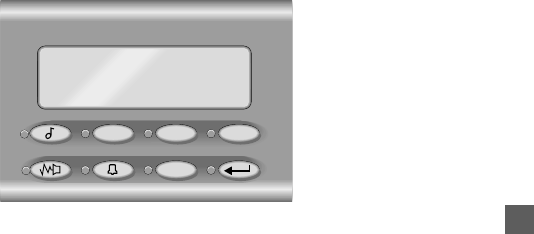
13
Transmit Timer
Your T2020
II
is fitted with a preprogrammed timer to limit the maximum length of transmissions.
When the time limit is reached, the radio sounds a three tone warning, and transmission is termi-
nated.
Economy Mode
The T2020
II
incorporates an Economy mode which conserves battery power by turning off some
internal circuitry, and dimming the control head back-lighting. This occurs after a predetermined period
of inactivity.
When Economy mode is active, the display backlighting dims or switches off.
Operating any of the control head controls, or the PTT key, restores the radio to full activity immedi-
ately.
Scanning Channels
Your T2020
II
can be programmed with the scanning facility, which enables it to sequentially monitor a
number of channels, pausing its search when it detects activity on a channel. To change the channels
included in your scan group, refer to ‘User Programmable Scan’.
To Activate Scanning
Set the radio scanning through a list of preprogrammed channels, as follows:
●
Ensure the microphone is placed on its hook. (Your radio may be programmed to scan when-
ever the microphone is off-hook. Consult your Tait dealer for more information on this feature.)
●
Select the appropriate scan group in the same way as selecting a channel (see ‘Selecting a
Channel’). The SCAN indicator appears in the display window, and scanning commences.
STAT Ch
Fn
α
SCAN
T2000
II

14
The T2020
II
now repeatedly scans through all programmed channels, searching for activity. When
activity is detected on a channel, the scan is halted, and the display window shows the active channel’s
name. (If signalling options are active in the radio, only activity with valid signalling tones halts the
scanning.) The radio pauses and unmutes on that channel, as long as the traffic remains, and the
SCAN indicator flashes. Scanning resumes after a short delay, once the traffic disappears.
You may change channel if you wish, but this cancels Scan mode. Otherwise, converse in the normal
manner and, when finished, place the microphone back on its hook to restart the scan.
To Stop Scanning
Scan mode is cancelled by selecting any non-scanning channel. The SCAN indicator then disappears
from the display window.
Making a Call
If you wish to make a call when the radio is in Scan mode, you may lift the microphone off-hook at any
time to suspend scanning. If the radio has halted scanning to monitor the traffic on a channel, it remains
on that channel when you lift the microphone off-hook. If the radio has found no traffic (i.e. has not
halted), it reverts to the preprogrammed home-channel.
Using Selcall (Selcall Option Fitted)
By using Selective Calling (Selcall), you can make calls to specific individuals or groups, on particular
channels. To use Selcall, your T2020
II
must be fitted with a Selcall module, and each channel prepro-
grammed to provide its own Selcall identity.
Making a Selcall Call
Call another party using Selcall, as follows:
1. Check that the radio is on the correct channel and that the channel is clear before attempting to
make the call.
2. Select the appropriate channel for the party you wish to contact (see ‘Selecting a Channel’).
3. If your radio is programmed with the ability to make a ‘one touch’ call to one other user (usually
your base or despatcher), press the Call ( ) key for about one second. The TX indicator
appears in the display briefly, and your radio sounds a short
beep
as the call is transmitted.
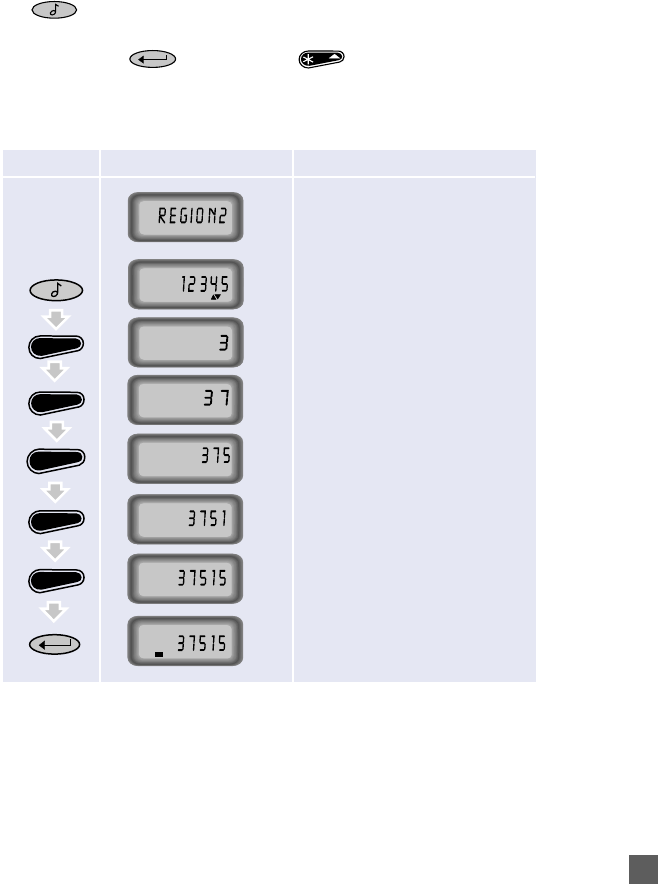
15
Last number called
1st digit of the new number
2nd digit of the new number
3rd digit of the new number
4th digit of the new number
Call placed
Current channel
Press key Characters displayed Explanation
7
PQRS
3
DEF
5JKL
5
JKL
1
TX
5th digit of the new number
4. If your radio is programmed with the ability to call other users with Selcall on your channel, press
the Call ( ) key briefly to activate Selcall mode. Use your keypad to enter the call code for
the other user. Each digit appears in the display as it is entered. When you have entered all of the
digits, press the Enter ( ) key or the Star ( ) key, to send the call.
Example:
You wish to call another user on the current channel (REGION 2), with the number 37515.
The sequence of keystrokes, and the corresponding display characters that appear, is as follows:
5. When the party you called replies, lift the microphone off-hook and press the PTT key to converse.
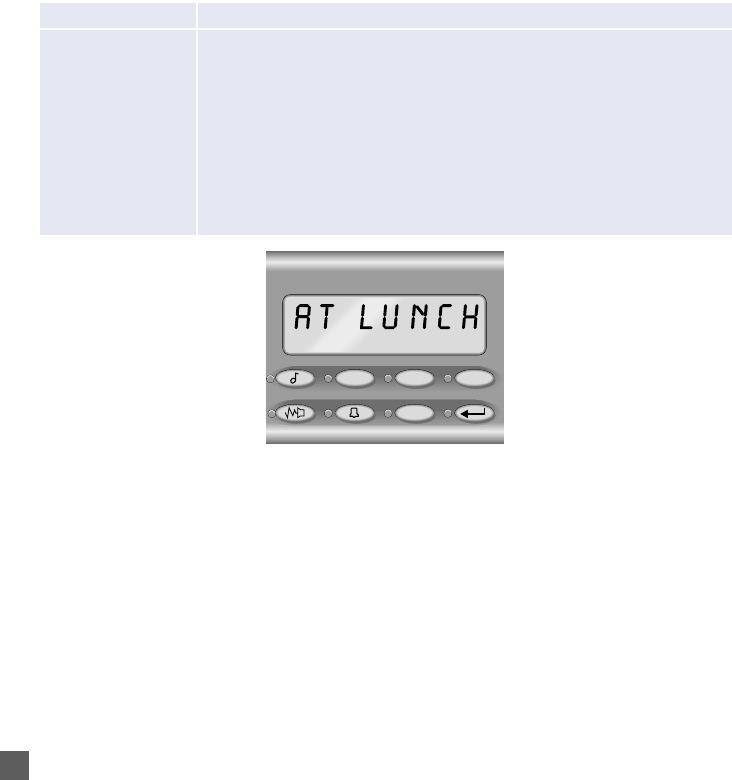
16
STAT
Ch
Fn
α
T2000II
6. After the call is sent, you may hear an acknowledging tone,
beep
, or series of tones from the other
user’s radio, indicating that your call has been received. If you do not hear a tone, either the other
user's radio is incapable of generating the acknowledging tone, or it is off, or they are out of range
of your call.
Your T2020
II
may be programmed to display the status of the called unit, as follows:
Status displayed Explanation
‘-NO ACK-’No acknowledge sequence was detected.
‘NO STAT’An acknowledge sequence was detected but no status information was de-
coded.
Status message An acknowledge sequence was detected and the decoded status number
can be identified.
Status number An acknowledge sequence was detected and the decoded status number
cannot be identified.
If any control head activity is detected before any of the above messages are displayed, the acknowl-
edge sequence is no longer expected, and messages will therefore no longer be displayed.
Group Calls
If you wish to call a group of other users, you may do so by dialling the digits common to all members of
the group and then using the # character as a substitute for all the remaining digits. If you are not sure
whether this facility has been programmed into your radio, consult your Tait dealer.
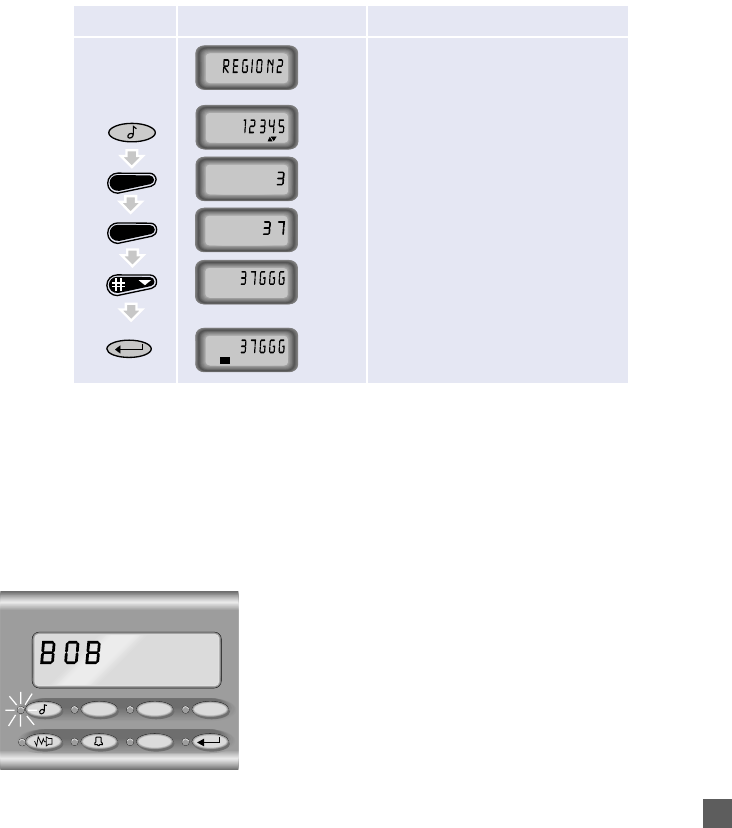
17
STAT
Ch
Fn
α
T2000
II
7
PQRS
3
DEF
TX
Press key Characters displayed Explanation
Current channel
Last number called
1st digit of the new number
2nd digit of the new number
Group wild card character
Call placed to all 37??? users
Example:
You wish to call a group of users on the current channel (REGION2) with numbers which all
begin with 37, and have three more digits. After you have selected channel REGION 2, the sequence of
keystrokes, and the corresponding display characters that appear, is as follows:
When the group call has been sent, there is no acknowledging tone from any of the other users. Wait a
few seconds after the TX indicator in the display window disappears and then broadcast your message.
Phrase your message in such a way that it requires no acknowledgement, since the other users cannot
all reply at once.
Receiving a Selcall Call
When you receive a Selcall call, the CALL indicator flashes and a ringing tone (similar to that of a
telephone) sounds from the speaker.
Note:
Your T2020
II
may be programmed to display the call-
er’s identity when you receive a call. Consult your Tait
dealer for more information on this feature.
●
To answer the call, lift the microphone off-hook and identify
yourself. As soon as you operate the PTT key, the ringing
tone stops.
●
If you do not answer the call within a short time, the ringing tone
stops. The radio may then switch on another alerting device
(e.g. the horn in your car) to attract your attention.

18
●
Your T2020
II
may be programmed to queue incoming calls. If this feature is enabled, the caller’s
identity is put in the queue after the ringing stops. All other call indicators are cleared when the
received call has been queued. (Refer to the section ‘Call Queuing’ for more information.)
●
If the call was not queued and you are still unable to answer the call, the radio indicates that a call
was received in your absence by leaving the CALL indicator flashing.
●
If you do not wish to answer a call, the ringing may be cancelled at any time by pressing any of the
control head keys. (The function associated with the key you press will not be invoked.) Note that
if the caller’s identity was displayed and the call was still not answered, pressing the Enter ( )
key clears the call and initiates an immediate call-back to the caller.
●
If you are one of the recipients of a group call, your radio only sounds a single sequence of the
ringing tone,
burr burr
. The caller then broadcasts a message to all members of your group.
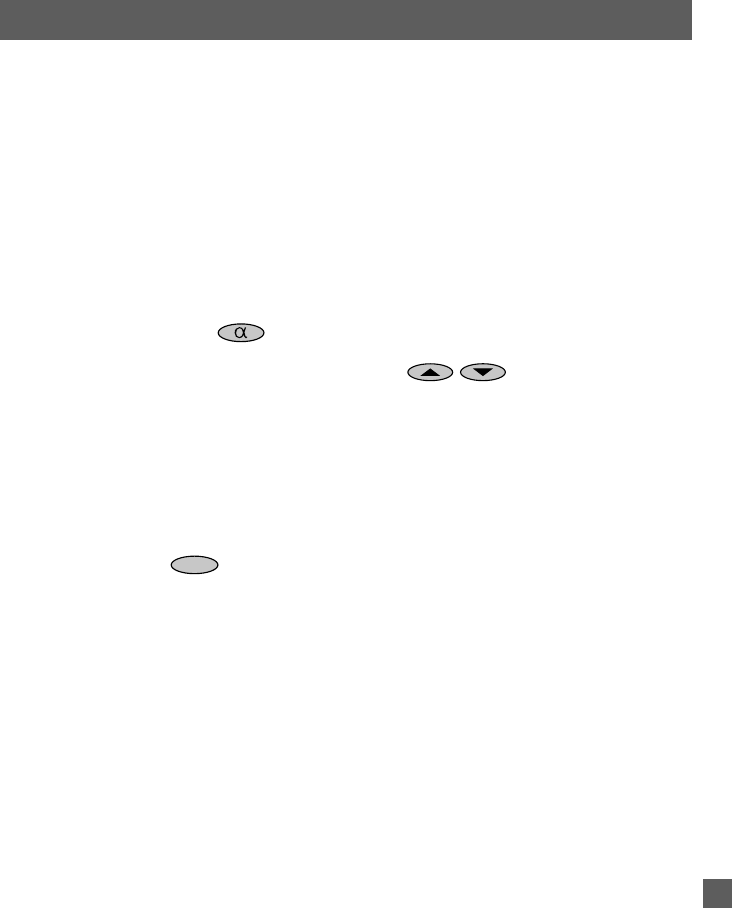
19
Advanced User Operations
Most of the special features detailed below must be enabled during programming of the T2020
II
. Con-
sult your Tait dealer to find out which of these features have been enabled in your radio.
Alphanumeric Entry Mode
The T2020
II
contains a number of memory locations which are able to be accessed with an alphanu-
meric entry or label, from the keypad. The alphanumeric label may be the same as a channel name or
it may be a quite separate word, person’s name or acronym which helps you find the appropriate
memory location. Each location contains information which selects a channel scan group, makes a
Selcall or DTMF call or selects a new Selcall status code.
Select a memory location by its alphanumeric label, as follows:
1. Press the Alphanumeric ( ) key to enter Alphanumeric mode.
2. Locate the desired label by using the Up and Down ( /) keys to scroll through the
list until the label is displayed. Alternatively, enter the label associated with the party you want,
using the keypad.
A star appears in the display as you type each character, until you have entered enough for the
radio to recognise the label. When it does, it displays the label in full. Pressing the Enter key
causes any instructions (channel selection, send call, and so on) contained in the memory
location to be carried out.
3. Press the Channel (
Ch
) key and the display changes from the label to the channel name. (The
radio may be programmed to return to the channel name display after a short while, anyway.)
Example:
You wish to call your BASE, which monitors a channel called REGION2 and has the Selcall
code 24624. The sequence of keystrokes, and the corresponding display characters that appear, is as
follows:
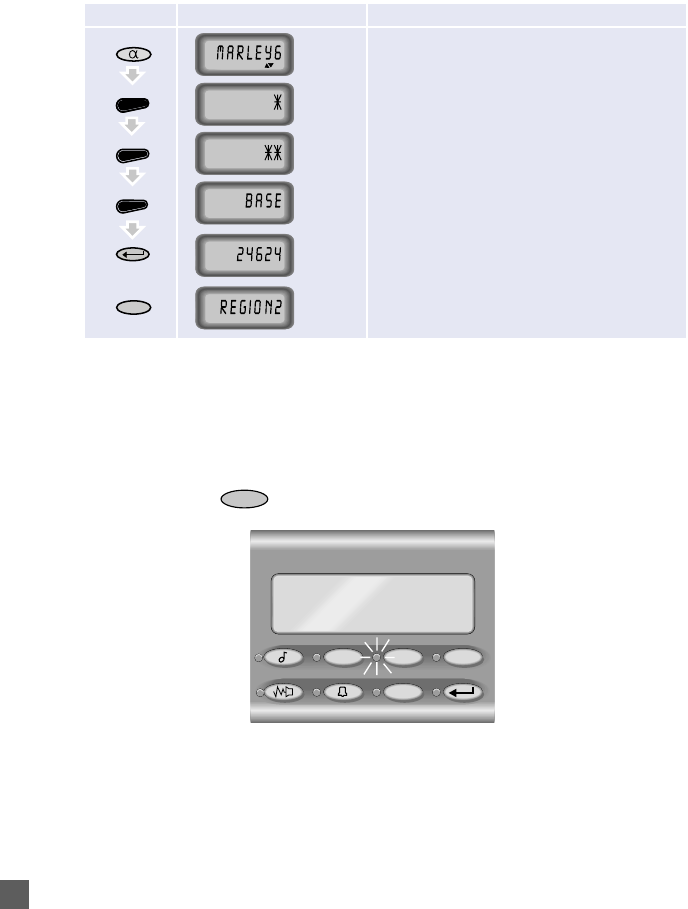
20
Last label entered
Unable to determine new label
Explanation
Unable to determine new label
New label identified
Characters displayed
Channel REGION2 selected and
Selcall code transmitted
Channel for BASE displayed
Press key
7
PQRS
2
ABC
2
ABC
2
ABC
Ch
STAT Ch
Fn
α
T2000II
Repeater Talkaround
Repeater Talkaround is a programmable option that allows your T2020
II
to bypass the repeater, and
transmit and receive calls directly on the repeater transmit frequency. This feature can be used, for
example, when you are out of range of the repeater.
1. Press the Channel (
Ch
) key for longer than 1 second.
The CHANNEL indicator should now be flashing, indicating that the T2020
II
is now in Repeater
Talkaround mode.
2. Select the appropriate channel and proceed with your call in the usual manner.

21
Sending DTMF Tones (DTMF Option Fitted)
The keypad on the T2020
II
may also send Dual Tone Multiple Frequency (DTMF) tones (consult your
Tait dealer to see if this option is fitted to your radio). This gives you the ability to dial telephone num-
bers, if your radio network has an interconnection to the Public Switched Telephone Network (PSTN),
or to send tones as control codes to remote devices.
1. To enter DTMF mode, observe which of the mode key indicators is currently illuminated (i.e. Call,
Status, Channel, Alphanumeric or Function) and push that key to deactivate the function. This
leaves the radio in DTMF mode, with the last number dialled showing in the display window.
2. Press the Enter ( ) key and the radio redials the number in the display.
3. Dialling a new number may be done digit by digit or as a complete number, as follows:
- To transmit the tone with each key-press (i.e. ‘live’), press the PTT key on the microphone as you
dial. (Your radio may be programmed so that you need only press the number key.) The TX
indicator appears in the display as you dial.
- To set up a complete sequence of digits, push each number key in turn without pressing the PTT
key (although your radio may be programmed to transmit the tones live, anyway). Each number
appears in the display.
- When the sequence is complete, press the Enter key to transmit the digits. Even if the digits have
been transmitted live, they are now retransmitted as a group.
In this mode, the transmission time of each digit is set by the radio, and is usually shorter and
more efficient than sending the tones live.
4. Pressing any of the keys on the keypad causes the corresponding DTMF tone to sound, but this
does not indicate whether or not the tone has actually been transmitted. Watch your radio’s dis-
play to see if the TX indicator appears (without the PTT key pressed).
5. To access special DTMF tones A to D, your radio may be programmed to use the PTT key as a shift
key, to alter the function of some of the keypad keys, as follows:
- PTT +
2
ABC
gives DTMF tone A
- PTT +
5
JKL
gives DTMF tone B
- PTT +
8
TUV
gives DTMF tone C
- PTT +
0
gives DTMF tone D
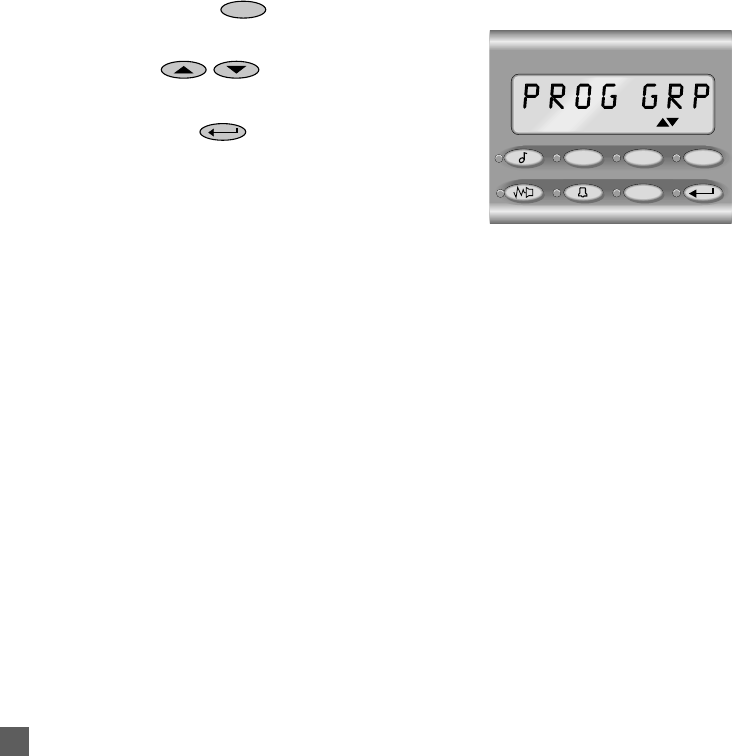
22
STAT Ch
Fn
α
T2000II
User Programmable Scan
Depending on how your T2020
II
is programmed, you may be able to change the channels that are
included in your scan group. Existing channels can be removed and new channels can be added, as
required.
Edit the user programmable scan group, as follows:
1. Press the Function (
Fn
) key.
2. Scroll through the items in the display window using the Up
and Down ( /) keys, until ‘PROG GRP’ is dis-
played.
3. Press the Enter ( ) key. The name of the group is
displayed, and the top row of indicators is illuminated.
4. Press the Enter key a second time to start the editing the
group.
5. Press the Up and Down keys to scroll through all the available channels. The SCAN indicator
indicates those channels that are included in the user programmable scan group, and a flashing
SCAN indicator indicates the home channel.
6. To add or delete a channel from the scan group, select the required channel and then press the
Enter key.
Note:
A scan group must contain 2 to 16 channels.
The home channel is defined by selecting a channel and then holding the Enter key for longer than 1
second. The SCAN indicator then flashes.
Note:
You can only delete a normal channel from the scan group. If the home channel is to be deleted
from the scan group, you first have to define another channel as home channel and then delete
the original home channel.
7. Once the group editing is complete, press the Function key to return to the Function menu.
8. Press a mode key to switch to another mode, if desired. Alternatively, the inactivity timer returns
the radio to the normal operating mode if no operator activity has been detected for 10 seconds.
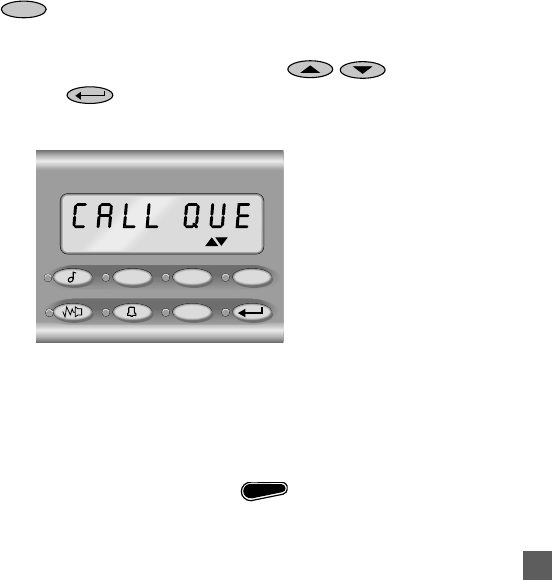
23
STAT
Ch
Fn
α
T2000
II
Call Queuing (Selcall Option Fitted)
Your T2020
II
can be preprogrammed to queue incoming calls. This feature enables the storage of up
to 10 caller identities.
Call Queue Not Empty
Whenever there is an entry in the call queue, the Function menu is automatically active, with ‘CALL
QUE’ appearing in the display window as the current item. This means that the radio always reverts to
the Function menu after a period of no-user activity, as long as there is a call queue entry. In addition,
the FUNCTION indicator flashes whenever the Function menu is active.
Accessing the Call Queue
The Call queue can be accessed through the Function menu. This is the same mode that is used to alter
user options.
1. Press the Function (
Fn
) key. The item last viewed while in this mode appears in the display
window.
2. Scroll through the displayed items using the Up and Down ( /) keys, and select
‘CALL QUE’ using the Enter ( ) key.
You are now in Call Queue Entry mode.
Note:
Call Queue Entry mode can only be accessed if there are entries in the call queue.
In Call Queue Entry mode, the display window shows the current entry number, and the total
number of entries in the list. An example of the display would be ‘CL 01/02’, indicating that the
current entry is entry number one, with a total of two entries in the queue. Use the Up and Down
keys to scroll through the list of entries, and the Zero (
0
) key to delete an entry from the
queue.

24
3. Press the Enter key, and the caller identity of the entry in the display window appears. Again, you
can use the Up and Down keys to scroll through the list of entries, and the Zero key to delete the
entry from the queue.
4. Press the Enter key again when the caller identity of the entry is being displayed, and call-back is
initiated. The entry is then automatically removed from the queue. Note that the call-back se-
quence is based on the caller identity.
Exiting the Call Queue
Exit Call Queue Entry mode by pressing any mode key, including the Function (
Fn
) key.
The radio automatically exits from Call Queue Entry mode, and reverts to the Function menu, if the last
entry in the call queue is deleted. This can be done either by using the Zero key, or making a call-back.
Queuing Calls
The caller identity and the channel of the received call is put in the call queue when:
●
The internal alert (ringing) of the received call stops
●
Another call is received before the previous one is queued.
Note:
After the incoming call has been queued, it is automatically cleared or answered, and the radio
resumes what it was doing prior to receiving the call. This includes the resumption of scanning,
if the radio was scanning prior to receiving the call.
Call Queue Full
Whenever the queue is full, the radio continues to receive calls, but does not resume what it was doing
prior to receiving the call (e.g. scanning). This allows calls to be received only on the held channel.
Subsequent calls that are received overwrite the information about the previous call.
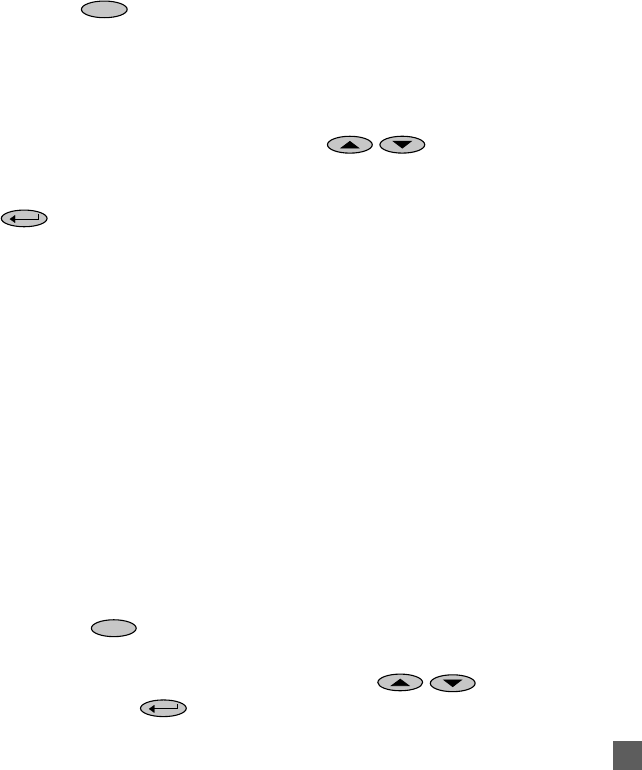
25
Changing the Selcall Status Code (Selcall Option Fitted)
If your radio is fitted with Selcall, you may also be able to choose from a number of activity codes to be
sent with each call you make, indicating your current status. Each code’s description and number (0 to
99) is set when the radio is programmed. Typical descriptions might be ‘AT LUNCH’, ‘EN ROUTE’, and
so on.
1. Press the Status (
STAT
) key to enter Status mode. How status codes are displayed by your
radio depends on which status display function is active (see the later section, ‘Altering User
Options’).
2. If ‘normal display’ (STAT NRM) is active, the complete eight character word for the currently
selected status is displayed.
Scroll through the choices using the Up and Down ( /) keys, until you find one
appropriate for your present activity. Alternatively, type the number for your new status directly
using the keypad. The new status description appears in the display (you may need to press the
Enter ( ) key first).
3. If ‘fixed display’ (STAT FIX) is active, your own status is displayed as a code at the right of the
display (along with the channel name, truncated to six characters).
Scroll through the choices using the Up and Down keys. Again, you may enter the number for
your new status directly using the keypad. The new status code appears in the display (you may
need to press the Enter key first).
4. The status code is sent when your radio acknowledges another user’s call.
Diverting a Received Call (Selcall Option Fitted)
This feature enables the radio to be put into Call Diversion mode, where any valid incoming Selcall
sequence causes the radio to transmit another user defined Selcall or DTMF sequence on the pro-
grammed call diversion channel. The sequence (number) to be transmitted and the call type (Selcall or
DTMF) can be entered by the user while in Call Diversion Setup mode.
Activating Call Diversion Setup Mode
Call Diversion Setup mode can be accessed through the Function menu.
1. Press the Function (
Fn
) key. The item last viewed while in this mode appears in the display
window.
2. Scroll through the displayed items using the Up and Down ( /) keys, and select
‘DIVERT’, using the Enter ( ) key.
The call diversion setup process has now been initiated.
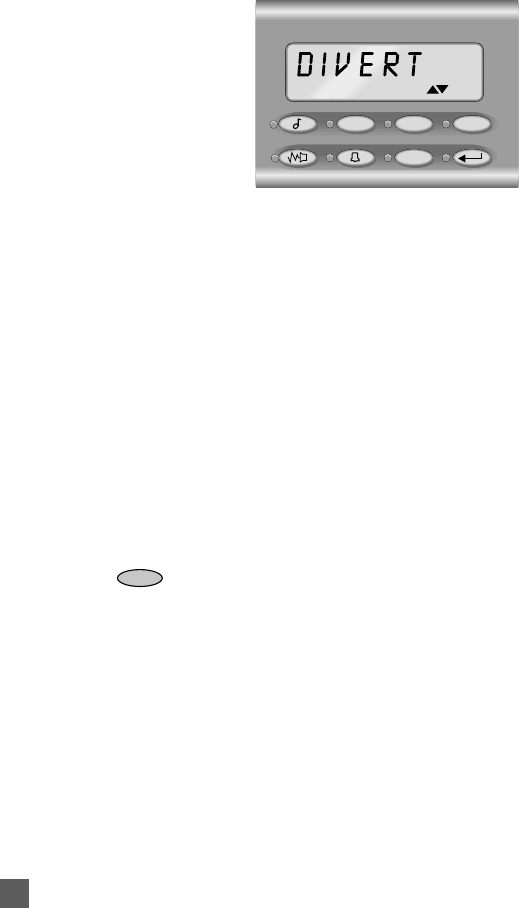
26
STAT Ch
Fn
α
T2000
II
3. On entry into the setup process, the display flashes the last selected diversion call type, either
Selcall or DTMF. Use the Up and Down keys to toggle between the two options. Note that if the
DTMF option has not been fitted on the radio, the DTMF call type will not be an option.
4. Press the Enter key to confirm the call type selected, and the last selected sequence is displayed,
if still valid. If the last selected sequence is no longer valid, the default sequence is displayed.
5. If another sequence is required, use the numeric keypad to enter the new diversion sequence.
Note that the correct sequence length must be entered (consult your Tait dealer for more informa-
tion on this).
6. Press the Enter key to confirm the diversion sequence and to put the radio into Call Diversion
mode.
Exiting Call Diversion Mode
At any stage of the call diversion setup process, any mode key-press initialises that mode, and there-
fore takes the radio out of the Call Diversion Setup process or Call Diversion mode. This includes the
Function (
Fn
) key.
Receiving a Call During Call Diversion
When a standard incoming call is received by the radio in Call Diversion mode, the programmed auto-
acknowledge sequence is transmitted, as for a normal call. However the programmed diversion status
is transmitted instead of the normal acknowledge status, to inform the caller that the call has been
diverted.
The radio then switches to the programmed call diversion channel and transmits the sequence that has
been set up for the call diversion, without indicating to the user that an incoming call has been received
(no ringing). After executing the diversion transmission, the radio reverts to the channel it was on prior
to the call diversion.

27
Making a Call to a Radio In Diversion Mode
Your T2020
II
can be programmed to respond to a diversion status report when making a call. When it
detects the diversion status in the acknowledge from the radio it has called, it displays ‘DIVERT’, to
indicate that the call has been diverted. It then proceeds to switch to the programmed diversion chan-
nel.
Emergency Operation (Selcall Option Fitted)
Your T2020
II
can be set to make emergency calls to a preprogrammed party (usually your base or
your despatcher). To use this capability, the radio must be fitted with the Selcall option, and be con-
nected to a hidden emergency switch. Alternatively, the Auxiliary ( ) key on the control head may
be preprogrammed to send an emergency call.
1. To send an emergency call, operate the hidden switch, or press the Auxiliary ( ) key. There
is no change in the T2020
II
control head indicators, but the radio sends a Selcall emergency
code to the preprogrammed party every few seconds, until it receives an acknowledging Selcall
code.
Note:
The emergency cycling option is controlled at the time of programming. If emergency cycling
is disabled, then the emergency sequence is sent only once, and no transmit/receive cycling
occurs.
2. The radio then adopts a transmit/receive cycle, which allows the base or despatcher to monitor
activity in the vicinity of the radio.
The radio can be removed from this mode either by receiving a reset code from the base or despatcher,
during one of its receive periods, or by turning the radio off and back on, without operating the emer-
gency switch.
A trailing alarm tone can be sent with the emergency sequence, if the alarm tone was enabled when the
radio was programmed.
Other Selcall Features
Your T2020
II
may be programmed with other Selcall functions. Consult your Tait dealer for more infor-
mation on the following functions:
●
Quiet Status Interrogation (QSI)
●
Automatic Numbering Identification (ANI)
●
Stun
●
Deferred Calling
●
Cancel call indicators on remote reset
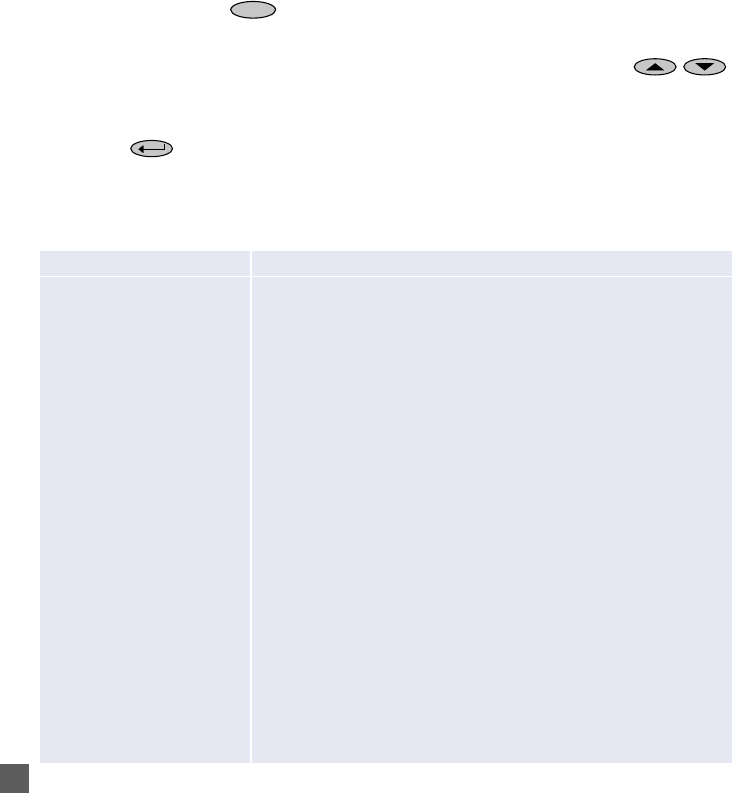
28
DescriptionOption
Altering User Options
While most of the features available on the T2020
II
are able to be customised with the Tait program-
ming software, some may be directly accessible to you, to alter according to your own requirements.
This is done via the Function menu, as follows:
1. Press the Function (
Fn
) key, and the item last viewed while in this mode appears in the
display window.
2. Scroll through the items in the display window, by pressing the Up and Down ( / )
keys.
3. Most Function menu items have an ‘on’ and ‘off’ setting. To change the current setting, press the
Enter ( ) key.
4. To exit the Function menu, press any of the other function keys. The radio may also be pro-
grammed to return to one of the other modes after a short while, anyway.
The following table shows Function menu options that can be changed in this way.
A-TX ON / A-TX OFF Selects whether or not the radio automatically transmits when DTMF
digits are dialled.
BEEP ON / BEEP OFF Selects whether or not your radio sounds key-press confidence tones
(
beeps
).
BEEP HI / BEEP LOW Alters the loudness of the confidence tones (
beeps
).
ELIT DIM / ELIT OFF Adjusts the display’s economy mode backlighting level between
dimmed and off.
HUSH ON / HUSH OFF Selects whether the radio is able to mute an external device, such
as a car stereo, when you transmit or receive a call. (This function
also requires the radio to be equipped with the necessary hardware
interface.)
HORN ON / HORN OFF Selects whether the radio sounds a vehicle horn, or similar device, when a
received call is unanswered. (This function also requires the radio to be
equipped with the necessary hardware interface.)
LITE FUL / LITE DIM Adjusts the display’s normal backlighting level between full and
dimmed.
STAT NRM / STAT FIX Selects whether your Selcall status is displayed as a full word or a
number.

29
The Call Diversion Setup, Call Queue Setup and User Programmable Scan modes are also accessed
from the Function menu. Refer to the sections ‘Diverting a Received Call’, ‘Call Queuing’ and ‘User
Programmable Scan’ for details.
Signalling options can be altered in the Function menu item ‘PROG SIG’. For more information on this,
contact your Tait dealer.

30
Optional Accessories for the T2020II Radio
The following accessories are available for use with your T2020
II
radio:
!
Handsfree Microphone with Remote or Voice-activated PTT key
!
Desktop Microphone
!
Remote Speaker
!
DTMF Microphone
!
Six Metre Remote Mounting Kit
!
Desktop Mains Power Supply (T2008)
!
600 Ohm Line Interface Kit
!
Computer Controlled Interface (CCI) Kit
!
DTMF Tone Kit
!
Selcall Kit
!
Scrambler Kit
See your Tait dealer for more details.
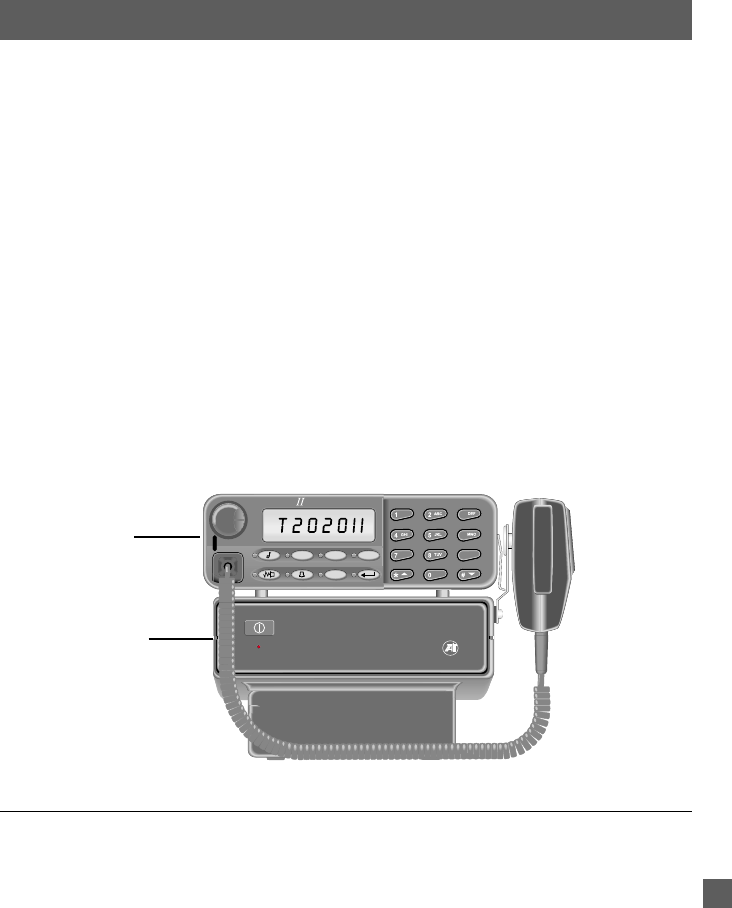
31
Appendix
Maintenance of your T2020II
The T2020
II
requires no regular maintenance, other than ensuring that all cables and connections are
secure, and that no damage has occurred to the antenna or wiring.
Troubleshooting
If the front panel indicators do not light up when you turn the radio on, it is likely that no power is
reaching the T2020
II
. Check the following:
!
Is the power connector firmly plugged into the rear of the T2020
II
?
!
Are the in-line fuses in good condition?
!
Is the power cable securely connected to the vehicle battery or power supply?
If all appears to be in order, then contact your Tait dealer for further assistance.
Despatcher Operation
The T2020
II
can also be used for despatcher operation, mounted on top of its companion T2008 power
supply, which is available separately. Consult your Tait dealer for more information.
Radio Unit
T2008 Power
Supply
3
6
9
PQRS
WXYZ
STAT
Ch
Fn
α
T2000
Power Supply
T2000
Tait Electronics has made every effort to ensure the accuracy of information in this manual. However,
Tait Electronics reserves the right to update the radio and / or this manual without notice.

2/01 IPN: 409-20200-03
Excellence in
Radio Communications
HEAD OFFICE NEW ZEALAND
Tait Electronics Ltd
P.O. Box 1645, Christchurch
Phone : (64) (3) 358-3399 Fax : (64) (3) 358-3636
AUSTRALIA
Tait Electronics (Aust) Pty Ltd
Phone : (61) (7) 3260-7799 Fax : (61) (7) 3260-7990
Toll Free : (1800) 07-7112
CANADA
Tait Mobile Radio Inc
Phone : (1) (905) 472-1100 Fax : (1) (905) 472-5300
Toll Free : (1) 1-800-890-8248
FRANCE
Tait France S.A.R.L.
Phone : (33) (1) 41-14-05-50 Fax : (33) (1) 41-14-05-55
GERMANY
Tait Mobilfunk GmbH
Phone : (49) (911) 96746-0 Fax : (49) (911) 96746-79
HONG KONG
Tait Mobile Radio (Hong Kong) Ltd
Phone : (852) 2369 3040 Fax : (852) 2369 3009
NEW ZEALAND
Tait Communications Ltd
Phone : (64) (3) 348-3301 Fax : (64) (3) 343-0558
SINGAPORE
Tait Electronics (Far East) Pte Ltd
Phone : (65) 471-2688 Fax : (65) 479-7778
TAIWAN
Tait Mobile Radio (Taiwan) Ltd
Phone : (886) 2-731-1290 Fax : (886) 2-711-6351
THAILAND
Tait Mobile Radio Ltd
Phone : (662) 2676290-2 Fax : (662) 2676293
UNITED KINGDOM
Tait Mobile Radio Ltd
Phone : (44) (1480) 52255 Fax : (44) (1480) 411996
U.S.A.
Tait Electronics (USA) Inc
Phone : (1) (713) 984-8684 Fax : (1) (713) 468-6944
Toll Free : 1-800-222-1255
T2020II